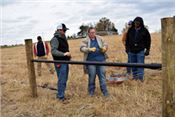Fencing School Fulfills Need For Small Ruminant Producers

Knox County producer Cheri Gillette learns how to construct a fence for small ruminants with help from Clay
Brewer with Stay-Tuff Fencing as other Kentucky Fencing School participants look on.
Photo by Katie Pratt, UK agricultural communications
KATIE PRATT
FRANKFORT, KENTUCKY
No matter the animal, livestock producers know a well-constructed fence is invaluable to successful herd management. To help small ruminant producers learn about sound, secure fencing, the University of Kentucky and Kentucky State University recently hosted a school specifically focused on them.
“All the basics of fencing for small ruminants is the same as fencing for cattle except small ruminants need a different wire type, and if producers use electric fencing, the line has to be lower,” said Chris Teutsch, forage extension specialist in the UK College of Agriculture, Food and Environment.
Teutsch has held fencing schools for many years with help from industry professionals, but the previous schools have been specifically focused on larger animals. This is the first Kentucky Fencing School he has hosted dedicated to small ruminants.
The school focused on small ruminants due to the increasing interest in the animals across Kentucky. Small ruminants are attractive to producers, especially those just getting into agriculture, because they don’t require a lot of acreage.
“There are a lot of people who buy farms with bad fencing. This school helps ensure producers know what they are doing and that they get their fences built right,” said Ken Andries, associate professor of animal sciences and associate dean for Kentucky State University’s College of Agriculture, Community and the Sciences. “Regardless of what animal a person is raising, producers could benefit from a good fencing school. A well-built fence works and poorly built fences are a problem.”
Cheri Gillette drove 2.5 hours from Woollum in Knox County to attend the Frankfort fencing school. She and her husband have raised cattle for years but plan to get sheep in the spring.
“Some of the fencing on our property is gone. I want to use fencing to keep our animals out of the creek, and I want to learn about how to do it the right way,” she said. “At this school I’m learning ways to make the fence construction process easier and to make the fence last longer.” ∆
Contents made available by University of Kentucky